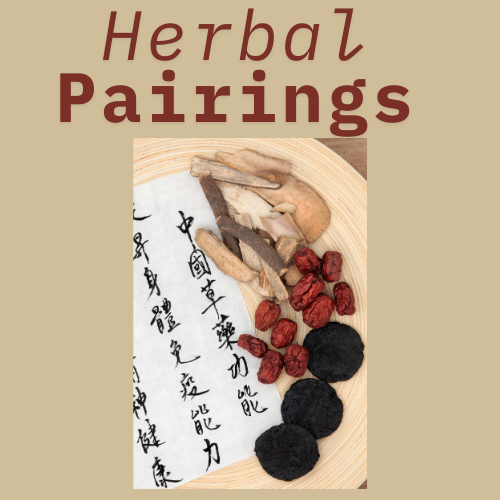Chinese Herbs That Work Better Together: 10 Powerful Herbal Pairings You Shouldn’t Miss

Thought: A single herb is a single remedy; many herbs together are a complete medicine
In Traditional Chinese Medicine (TCM), some herbs are simply better together. This principle—called Dui Yao, or herbal pairing—is the secret behind many time-honored remedies. Paired herbs often produce stronger, more balanced effects than using a single herb alone. Yet, most consumers don’t even know this practice exists.
In this guide, you’ll uncover 10 powerful herbal duos that support immunity, digestion, energy, sleep, and more. You'll learn why they work, how to prepare and combine them at home, what side effects to watch for, and when to use them for best results.
What Is Dui Yao in TCM?
Dui Yao means "paired herbs." These complementary combinations are crafted to:
-
Enhance each other's effects (herbal synergy)
-
Target specific TCM patterns (e.g., Liver Qi stagnation)
-
Balance Yin-Yang properties
-
Harmonize formulas for safety and potency
This wisdom is why most classical Chinese formulas contain more than one herb—even when treating one condition.
10 Synergistic Chinese Herbal Pairings You Shouldn’t Miss
| Herbal Pair | What It Supports | Why It Works (TCM) | How to Use | Dosage & Duration |
|---|---|---|---|---|
| Huang Qi + Dang Shen | Immunity, energy, fatigue | Tonifies Qi, strengthens Lung & Spleen | Decoction, powder, or capsule | 5–10g each, daily for 2–4 weeks |
| Fu Ling + Bai Zhu | Digestion, bloating, dampness | Dries damp, boosts digestion, strengthens Spleen | Decoction or powder with hot water | 4–6g each, after meals |
| Suan Zao Ren + Bai Zi Ren | Sleep, anxiety, palpitations | Nourishes Heart & Liver Yin, calms Shen | Tea, tincture, or teapill | 3–6g each, 30–60 mins before bed |
| Jin Yin Hua + Lian Qiao | Colds, sore throat, early infections | Clears heat and toxicity | Tea or tincture | 5–8g each, up to 3x/day at onset |
| Dang Gui + Chuan Xiong | Menstrual pain, circulation | Moves and nourishes Blood | Decoction or tincture | 4–6g each, days 1–5 of cycle |
| Zhi Zi + Dan Shen | Chest tightness, stress, heat | Moves blood, clears heat, calms Liver | Tea or tincture | 4–8g each, daily for 2–3 weeks |
| Yi Yi Ren + Bai Hua She She Cao | Skin & urinary detox | Clears damp-heat, detoxes skin | Capsules or tea | 5–10g each, 2–3 weeks |
| Qing Hao + Di Gu Pi | Night sweats, yin-deficiency heat | Clears deficient heat, nourishes Yin | Teapill or decoction | 3–5g each, daily for 3 weeks |
| Gou Teng + Tian Ma | Dizziness, hypertension | Calms Liver wind, anchors Yang | Decoction or teapill | 4–7g each, daily |
| Gan Cao + Sheng Jiang | Nausea, digestive upset, harmonizing formulas | Warms and harmonizes digestion, reduces toxicity of other herbs | Found in many classical formulas | 2–4g each as needed |
How to Safely Combine Chinese Herbs at Home
-
General Ratio: Use equal parts unless directed otherwise
-
Preparation: Use in teas (decoctions), capsules, or powders
-
ProTip: Use clean spring water and simmer gently when brewing
-
Best Time: Immune/energy herbs in the morning; calming herbs in the evening
Always consult your herbalist if you have a medical condition or take medications.
Common Side Effects & Contraindications
| Pair | Avoid If... |
| Huang Qi + Dang Shen | You have acute infections or fever |
| Dang Gui + Chuan Xiong | Heavy menstrual bleeding or blood thinners |
| Zhi Zi + Dan Shen | Taking heart medications |
| Qing Hao + Di Gu Pi | Cold constitution or pregnancy |
Note: This list is not exhaustive. Always consult a qualified practitioner.
TCM Theory Behind the Pairings
| Pair | TCM Pattern | Organ Systems |
| Fu Ling + Bai Zhu | Spleen Qi Deficiency with Dampness | Spleen, Stomach |
| Suan Zao Ren + Bai Zi Ren | Heart Yin Deficiency | Heart, Liver |
| Gou Teng + Tian Ma | Liver Wind Stirring Internally | Liver, Kidney |
| Yi Yi Ren + Bai Hua She She Cao | Damp-Heat | Bladder, Skin |
These combinations are designed not just to target symptoms but to resolve the underlying pattern of disharmony in the body.
Consumer FAQs
Q: Can I make these pairs as tea myself?
A: Yes. Use 1–2 teaspoons of each herb per 1.5 cups water. Simmer 15–30 minutes.
Q: How long should I take these herbs?
A: Acute symptoms: 3–7 days. Chronic patterns: 2–6 weeks, under guidance.
Q: Do I need to cycle off the herbs?
A: For long-term use, take a 5–7 day break after 3–4 weeks.
Testimonials
“I struggled with sleep for months. Suan Zao Ren and Bai Zi Ren worked better than anything I’ve tried—and without grogginess.” – Maria T.
“After using Fu Ling and Bai Zhu, my digestion has improved noticeably. I feel lighter and less bloated every day.” – Kevin R.
Helpful Links For Understanding Chinese Herbs
TCM Terminology
How To Use Herbs
Herb Forms To Suit Your Needs
Understanding The Benefits Of Teapills
Shop Trusted Herbal Pairings
All of our herbs are GMP-certified, geo-authenticated, lab-tested, and trusted by practitioners worldwide. We offer bundles and formulas based on these powerful combinations.
References (PubMed & Clinical Research)
-
Astragalus & Codonopsis: https://pubmed.ncbi.nlm.nih.gov/
-
Fu Ling & Bai Zhu: https://pubmed.ncbi.nlm.nih.gov/
-
Suan Zao Ren sedative effects: https://pubmed.ncbi.nlm.nih.gov/
-
Lian Qiao + Jin Yin Hua: https://pubmed.ncbi.nlm.nih.gov/
-
Dang Gui & Menstrual Health: https://pubmed.ncbi.nlm.nih.gov/
-
Dan Shen & Cardiovascular: https://pubmed.ncbi.nlm.nih.gov/
-
Yi Yi Ren: https://pubmed.ncbi.nlm.nih.gov/
-
Qing Hao & Malaria: https://pubmed.ncbi.nlm.nih.gov/
-
Tian Ma Neuroprotective: https://pubmed.ncbi.nlm.nih.gov/
-
Licorice Harmonization: https://pubmed.ncbi.nlm.nih.gov/

